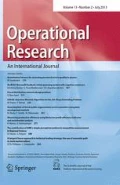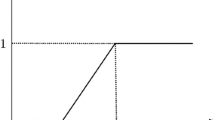Abstract
In this paper, we focus on stochastic two-level integer programming problems with cooperative decision makers. Using the fractile criterion optimization model in chance constrained programming, the formulated stochastic two-level integer programming problems are transformed into deterministic ones. Taking into account vagueness of judgments of the decision makers, we present an interactive fuzzy programming method to derive a satisfactory solution through interactions with the upper-level decision maker in consideration of the cooperative relation to the lower-level decision maker. For solving transformed deterministic problems efficiently, we also introduce genetic algorithms with double strings for nonlinear integer programming problems. An illustrative numerical example is provided to demonstrate the feasibility and efficiency of the proposed method.

Similar content being viewed by others
References
Abo-Sinna MA, Baky IA (2007) Interactive balance space approach for solving multi-level multi-objective programming problems. Inf Sci 177:3397–3410
Back T (1996) Evolutionary algorithms in theory and practice. Oxford University Press, New York
Back T, Fogel DB, Michalewicz Z (1997) Handbook of evolutionary computation. Institute of Physics Publishers, Bristol
Bellman RE, Zadeh LA (1970) Decision making in a fuzzy environment. Manag Sci 17:141–164
Charnes A, Cooper WW (1959) Chance constrained programming. Manag Sci 6:73–79
Coello CAC, Van Veldhuizen DA, Lamont GB (2002) Evolutionary algorithms for solving multi-objective problems. Kluwer, New York
Dantzig GB (1955) Linear programming under uncertainty. Manag Sci 1:197–206
Deb K (2001) Multi-objective optimization using evolutionary algorithms. Wiley, Chichester
Eiben AE, Smith JE (2003) Introduction to evolutionary computing. Springer, Berlin
Gen M, Cheng R (1996) Genetic algorithms and engineering design. Wiley, New York
Goldberg DE, Lingle R (1985) Alleles, loci, and the traveling salesman problem. In: Proceedings of 1st international conference on genetic algorithms and their applications, pp 154–159
Goldberg DE (1989) Genetic algorithms in search, optimization, and machine learning. Addison Wesley, Massachusetts
Holland JH (1975) Adaptation in natural and artificial systems. University of Michigan Press, Ann Arbor
Kataoka S (1963) A stochastic programming model. Econometrica 31:181–196
Kozieł S, Michalewicz Z (1999) Evolutionary algorithms, homomorphous mapping, and constrained parameter optimization. Evol Comput 7:19–44
Lai YJ (1996) Hierarchical optimization: a satisfactory solution. Fuzzy Sets Syst 77:321–335
Lai YJ, Hwang CL (1992) Fuzzy mathematical programming. Springer, Berlin
Lee ES (2001) Fuzzy multiple level programming. Appl Math Comput 120:79–90
Luhandjula MK (1987) Multiple objective programming problems with possibilistic coefficients. Fuzzy Sets Syst 21:135–145
Michalewicz Z (1992) Genetic algorithms + data structures = evolution programs. Springer, Berlin (1992). Second extended edition (1994). Third revised and extended edition (1996)
Pramanik S, Roy TK (2007) Fuzzy goal programming approach to multilevel programming problems. Eur J Oper Res 176:1151–1166
Roghanian E, Sadjadi SJ, Aryanezhad MB (2007) A probabilistic bi-level linear multi-objective programming problem to supply chain planning. Appl Math Comput 188:786–800
Rommelfanger H (1996) Fuzzy linear programming and applications. Eur J Oper Res 92:512–527
Sakawa M (1993) Fuzzy sets and interactive multiobjective optimization. Plenum Press, New York
Sakawa M (2000) Large scale interactive fuzzy multiobjective programming. Physica-Verlag, Heidelberg
Sakawa M (2001) Genetic algorithms and fuzzy multiobjective optimization. Kluwer, Boston
Sakawa M, Kato K (2008) Interactive fuzzy multi-objective stochastic linear programming. In: Kahraman C (ed) Fuzzy multi-criteria decision making—theory and applications with recent developments. Springer, New York, pp 375–408
Sakawa M, Nishizaki I (2002a) Interactive fuzzy programming for decentralized two-level linear programming problems. Fuzzy Sets Syst 125:301–315
Sakawa M, Nishizaki I (2002b) Interactive fuzzy programming for two-level nonconvex programming problems with fuzzy parameters through genetic algorithms. Fuzzy Sets Syst 127:185–197
Sakawa M, Nishizaki I (2009) Cooperative and noncooperative multi-level programming. Springer, New York
Sakawa M, Yano, H (1985) Interactive fuzzy satisficing method using augumented minimax problems and its application to environmental systems. IEEE Trans Syst Man Cybern SMC 15:720–729
Sakawa M, Yano H (1989) Interactive decision making for multiobjective nonlinear programming problems with fuzzy parameters. Fuzzy Sets Syst 29:315–326
Sakawa M, Yano H (1990) An interactive fuzzy satisficing method for generalized multiobjective linear programming problems with fuzzy parameters. Fuzzy Sets Syst 35:125–142
Sakawa M, Yano H, Yumine T (1987) An interactive fuzzy satisficing method for multiobjective linear-programming problems and its application. IEEE Trans Syst Man Cybern SMC 17:654–661
Sakawa M, Nishizaki I, Uemura Y (1998) Interactive fuzzy programming for multi-level linear programming problems. Comput Math Appl 36:71–86
Sakawa M, Nishizaki I, Uemura Y (2000) Interactive fuzzy programming for multi-level linear programming problems with fuzzy parameters. Fuzzy Sets Syst 109:3–19
Sakawa M, Nishizaki I, Uemura Y (2001) Interactive fuzzy programming for two-level linear and linear fractional production and assignment problems: a case study. Eur J Oper Res 135:142–157
Sakawa M, Nishizaki I, Uemura Y (2002) A decentralized two-level transportation problem in a housing material manufacturer—interactive fuzzy programming approach. Eur J Oper Res 141:167–185
Sakawa M, Kato K, Nishizaki I (2003) An interactive fuzzy satisficing method for multiobjective stochastic linear programming problems through an expectation model. Eur J Oper Res 145:665–672
Sakawa M, Kato K, Katagiri H (2004) An interactive fuzzy satisficing method for multiobjective linear programming problems with random variable coefficients through a probability maximization model. Fuzzy Sets Syst 146:205–220
Sakawa M, Kato K, Azad MAK, Watanabe R (2005) A genetic algorithm with double string for nonlinear integer programming problems. In: IEEE SMC 2005 conference proceedings. pp 3281–3286
Shih HS, Lai YJ, Lee ES (1996) Fuzzy approach for multi-level programming problems. Comput Oper Res 23:73–91
Shimizu K, Ishizuka Y, Bard JF (1997) Nondifferentiable and two-level mathematical programming. Kluwer, Boston
Sinha S (2003) Fuzzy programming approach to multi-level programming problems. Fuzzy Sets Syst 136:189–202
Slowinski R (ed) (1998) Fuzzy sets in decision analysis, operations research and statistics. Kluwer, Dordrecht/Boston/London
Slowinski R, Teghem J (eds) (1990) Stochastic versus fuzzy approaches to multiobjective mathematical programming under uncertainty. Kulwer, Dordrecht/Boston/London
Stancu-Minasian IM (1990) Overview of different approaches for solving stochastic programming problems with multiple objective functions. In: Slowinski R, Teghem J (eds) Stochastic versus fuzzy approaches to multiobjective mathematical programming under uncertainty, Kluwer, Dordrecht/Boston/London, pp 71–101
Zimmermann H-J (1978) Fuzzy programming and linear programming with several objective functions. Fuzzy Sets Syst 1:45–55
Zimmermann H-J (1987) Fuzzy sets, decision-making and expert systems. Kluwer, Boston
Author information
Authors and Affiliations
Corresponding author
Rights and permissions
About this article
Cite this article
Sakawa, M., Katagiri, H. & Matsui, T. Interactive fuzzy stochastic two-level integer programming through fractile criterion optimization. Oper Res Int J 12, 209–227 (2012). https://doi.org/10.1007/s12351-010-0085-z
Received:
Revised:
Accepted:
Published:
Issue Date:
DOI: https://doi.org/10.1007/s12351-010-0085-z




